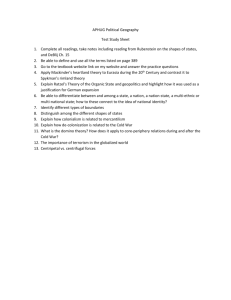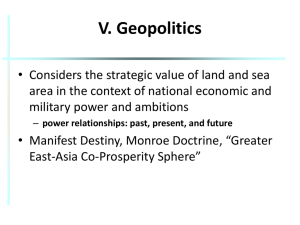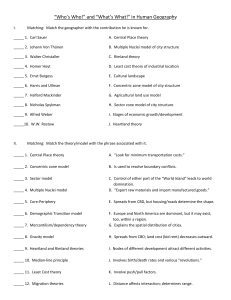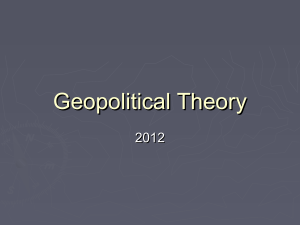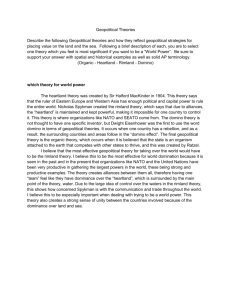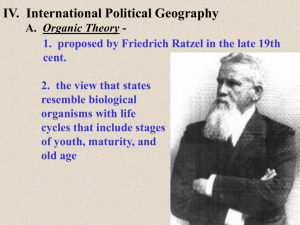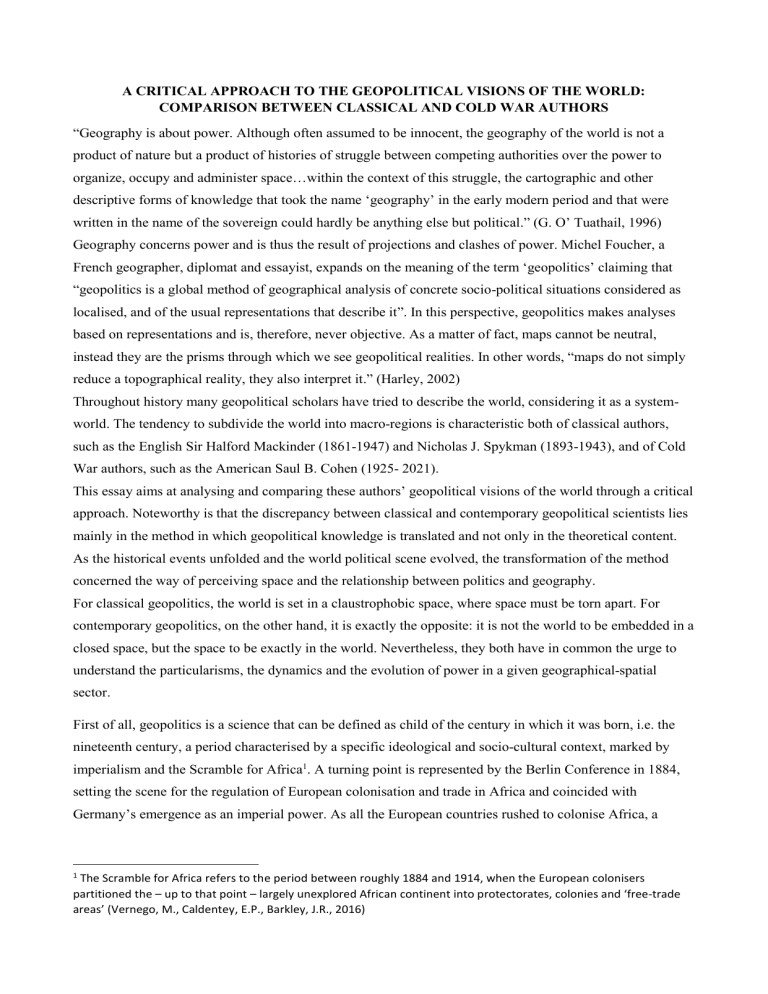
A CRITICAL APPROACH TO THE GEOPOLITICAL VISIONS OF THE WORLD: COMPARISON BETWEEN CLASSICAL AND COLD WAR AUTHORS “Geography is about power. Although often assumed to be innocent, the geography of the world is not a product of nature but a product of histories of struggle between competing authorities over the power to organize, occupy and administer space…within the context of this struggle, the cartographic and other descriptive forms of knowledge that took the name ‘geography’ in the early modern period and that were written in the name of the sovereign could hardly be anything else but political.” (G. O’ Tuathail, 1996) Geography concerns power and is thus the result of projections and clashes of power. Michel Foucher, a French geographer, diplomat and essayist, expands on the meaning of the term ‘geopolitics’ claiming that “geopolitics is a global method of geographical analysis of concrete socio-political situations considered as localised, and of the usual representations that describe it”. In this perspective, geopolitics makes analyses based on representations and is, therefore, never objective. As a matter of fact, maps cannot be neutral, instead they are the prisms through which we see geopolitical realities. In other words, “maps do not simply reduce a topographical reality, they also interpret it.” (Harley, 2002) Throughout history many geopolitical scholars have tried to describe the world, considering it as a systemworld. The tendency to subdivide the world into macro-regions is characteristic both of classical authors, such as the English Sir Halford Mackinder (1861-1947) and Nicholas J. Spykman (1893-1943), and of Cold War authors, such as the American Saul B. Cohen (1925- 2021). This essay aims at analysing and comparing these authors’ geopolitical visions of the world through a critical approach. Noteworthy is that the discrepancy between classical and contemporary geopolitical scientists lies mainly in the method in which geopolitical knowledge is translated and not only in the theoretical content. As the historical events unfolded and the world political scene evolved, the transformation of the method concerned the way of perceiving space and the relationship between politics and geography. For classical geopolitics, the world is set in a claustrophobic space, where space must be torn apart. For contemporary geopolitics, on the other hand, it is exactly the opposite: it is not the world to be embedded in a closed space, but the space to be exactly in the world. Nevertheless, they both have in common the urge to understand the particularisms, the dynamics and the evolution of power in a given geographical-spatial sector. First of all, geopolitics is a science that can be defined as child of the century in which it was born, i.e. the nineteenth century, a period characterised by a specific ideological and socio-cultural context, marked by imperialism and the Scramble for Africa1. A turning point is represented by the Berlin Conference in 1884, setting the scene for the regulation of European colonisation and trade in Africa and coincided with Germany’s emergence as an imperial power. As all the European countries rushed to colonise Africa, a 1 The Scramble for Africa refers to the period between roughly 1884 and 1914, when the European colonisers partitioned the – up to that point – largely unexplored African continent into protectorates, colonies and ‘free-trade areas’ (Vernego, M., Caldentey, E.P., Barkley, J.R., 2016) claustrophobic view of the world was perceived: the more they occupied space, the more they expanded and, therefore, the less space was available. Consequently, classical authors elaborate binary theories, highly influenced by this historical and political scenario. These are theories based on a binary construction that puts in opposition land and sea and seek the geo-historical element for the domination of the world. In this perspective, it is vital to keep in mind that geopolitics is a predictive and prescriptive discipline. On the one side, it aims at looking at the past in order to investigate the present and imagine and future scenarios. On the other side, geopolitics addresses the political power and attempts to make recommendations, in other words, what should be done to strengthen or change one future scenario rather than another. In specific, classical geopolitics wants to be a discipline that anticipates the history of the following centuries, in which contention for global domination will be particularly stressed. In conclusion, classical authors’ thinking is characterised by strong geographical determinism and quantitative obsession. Sir Halford Mackinder, a British author and one of the pioneers of Anglo-Saxon geopolitics, foresaw, as Alfred T. Mahan (1840- 1914) and Sir Julian Corbett (1854- 1922) before him, the breaking of the balance of power and the path to sea supremacy. In this regard, he identifies three fundamental elements that characterise his contemporary geopolitical world system: the pivot area, i.e. the Heartland; the Inner or Marginal Crescent, that consists of Western Europe, the Middle East, China, Germany, Austria and the Ottoman Empire; and, finally, the lands of Outer or Insular Crescent, i.e. the Sea power and the island powers as the USA, Japan and Britain. The Outer Crescent had dominated and had a concentration of power during the Columbian era, which is the historical era marked by the great oceanic discoveries in the Americas and the Indies. With technological progress, a strategical and geopolitical advantage transitioned to the power that dominated the pivot-area, which was the Tsarist Empire, or perhaps Germany, in the case of an advance eastwards and submission to or alliance with Russia (Mackinder, 1904). At the dawn of the twentieth century, Mackinder foreshadowed the breaking of the balance of power and the opportunity of the pivot-state to expand into the peripheral lands and gain access to the seas and oceans, thus preparing to dominate the world. Nevertheless, a question arises: what kind of advantage could the pivot-area (or Heartland, as Mackinder calls it) claim? The pivot area is viewed as the natural seat of power, it can own resources that no one else can boast of. Moreover, whoever occupies the Heartland has the possibility to take control of the globe central position, which is represented by the World-Island, a continental mass formed by Eurasia and Africa. In the final analysis, whoever controls the Heartland and thus the World-Island, has the power and all requirements to command the destinies of the world. However, since it has no access to the warm seas, the Heartland tends to push towards the peripheral areas of Central Europe, trying to control the vulnerable Inner Crescent, what Nicholas Spykman would have later called the Rimland. The Heartland’s pressures on the warm seas, that could be exploited to gain sea power and developing booming trades, represented an enormous jeopardy for Sea powers as Great Britain: indeed, they would risk the marginalisation from the World-Island in the event that the Heartland succeeded in compacting and controlling the Inner Crescent and thus the World-Island, becoming eventually the geo-historical element for global domination. In order to avoid this, the Sea power has to hinder the Heartland’s technological and economic strengthening and contrast its supremacy enacting a fragmentation of the World-Island. Nicholas Spykman, a Dutch-American political geographer and professor of International Relations at the University of Yale, draws on and extends Mackinder’s Heartland theory, developing a different approach. In his perspective, the Rimland (i.e. Mackinder’s Inner Crescent) is the geographical pivot of history and, therefore, by controlling the Rimland it is possible to control the world. Hence, it is not fragile and at the mercy of both the Heartland and Seapower, as Mackinder claimed. On the contrary, the Rimland can potentially dominate both the Heartland and the Seapower (Spykman, 1942). In addition, unlike Mackinder, Spykman points to the existence of multiple internal Crescents or Rimlands, each of which has its own security requirements, identifying three different Rimlands: the European coast land, the Arabian-Middle Eastern desert land and the Asiatic monsoon land. To conclude, it is blatant that Spykman adopts a different or even reverse perspective compared to Mackinder: whoever dominates the Rimland, controls the WorldIsland and thus the whole world. In conclusion, if Mackinder focuses on geographical size, Spykman firmly rejects any form of geographic determinism, claiming that geography does not force a state into doing anything, but instead only creates a strong predisposition towards a certain foreign policy. In this regard, he asserts how “the nature of the territorial base has influenced them (humans) in that formulation in the past and will continue to do so in the future. The nature of this base exerts a manifold influence on foreign policy” (1938). This tendency to subdivide the world into regions (Heartland, Rimlands, etc.) is distinctive also of postclassical authors such as Saul B. Cohen. Professor of Geography during the years of the Cold War, he proposes a vision of the world similar to that of the two mentioned classical authors. However, he avoids the schematism and the sharp division of the land-sea dichotomy, taking up the fundamental characteristics, but revisiting them in a more integrated and modern way. According to Cohen, in fact, the world is divided into geostrategic kingdoms and geopolitical regions, separated by shatterbelts. More specifically, a shatterbelt is a “large, strategically located region that is occupied by a number of conflicting states and is caught between the conflicting interests of adjoining Great Powers” (Cohen 1963). Along these fracture lines the tensions between the two opposing blocs could be discharged, avoiding a direct confrontation. On the one hand, the Heartland seeks the strategic unity of space and tries to compact it in the attempt to reach warm seas. Cohen calls it the Eurasian Continental Realm and it corresponds to the Soviet bloc. On the other hand, the sea power or Trade-Dependent Maritime Realm to use the term coined by Cohen corresponds to the great maritime communication routes that could advantage inter-oceanic trade. This geographic area corresponds to the US bloc. Behind the ideology of the two blocs there is a geopolitical substratum, which remains prevalent in Cohen's vision. Indeed, it is obvious and undisputable that within these two spheres there were profound political, economic, cultural, ethnic and religious differences. However, these divisions could be witnessed within geopolitical realities with greater homogeneity. Compared to other previous representations, these regions were smaller but more cohesive. In conclusion, Cohen's view reflects the clear bipolar contrast that is typical of most Cold War authors. Looking at Mackinder's and Spykman's representations compared to Cohen's, it is possible to see how the former tend to divide space horizontally, following parallels, while Cohen's representation tends to be vertical, following meridians, and partly embracing the system of pan-regions conceived by the author of the German school of Geopolitics Karl Haushofer (1869-1946). In fact, Haushofer imagined a variety of different pan-systems led by Japan, Germany and Russia, whose alliance Haushofer considered a foregone conclusion with a specific anti-French and English function. Nevertheless, Cohen's vision is more bipolar, made up of only two opposing poles, whose tensions were discharged onto the shatterbelts, in order to avoid a direct clash that would have led to a nuclear war and thus to the destruction of the world. Ultimately, although Geopolitics purports to be neutral, it is interesting to acknowledge, however, that the geopolitical representation, as the contemporary French geopolitical scholar Yves Lacoste (1929- ) points out, is never neutral, but is geographical knowledge used as an instrument of power. Worth of mention is one of Lacoste’s most famous works whose title is emblematic: Geography serves, first and foremost, to wage war (1976). In light of these considerations, it appears clear how the real aim of Spykman’s theories is to encourage the USA to maintain contact with the Rimland with an active foreign policy to avoid falling back into isolationism; Mackinder asserts the UK’s need to fragment the space, thus protecting its position on the Rimland and hinder the Heartland from dominating the world. Finally, Cohen argues for the need to penetrate the Heartland (i.e. the USSR) to prevent it from ‘winning’ the Cold War and ruling the world. It is thus evident that, depending on the nationality or the political ideology of the author, the representation never appears neutral and objective, but based on personal and arbitrary criteria. Words: 1991 REFERENCES Cohen, S.B. (1963) Geography and Politics in a World Divided. Oxford University Press Inc Cohen, S.B. (2015) Geopolitics. The geography of International Relations. Rowman & Littlefield Harley, J.B. (2001) The New Nature of Maps: Essays in the History of Cartography. The Johns Hopkins University Press Lacoste Y (1976) La Géographie, ça sert, d'bord, à faire la guerre. Editions La Découverte Mackinder, H.J. (1904) The Geographical Pivot of History (in The Geographical Journal vol. 23, no.4), The Royal Geographical Society Mackinder, H.J. (1919) Democratic Ideals and Reality. National Defence University Press Mackinder, H.J. (1943) The round world and the winning of peace (in Foreign Affairs vol. 21, no.4), Council on Foreign Relations O’ Loughlin, J., van der Wusten, H. (1990) Political Geography of Panregions (in Geographical Review vol. 80, no. 1), Taylor & Francis O’ Tuathail, G. (1996) Critical Geopolitics: The Politics of Writing Global Space. University of Minnesota Spykman, N. (1938) Geography and Foreign Policy (in American Political Science Review vol. 32, no. 1), Spykman, N. (1939) Geographic Objectives in Foreign Policy (in American Political Science Review). American Political Science Association Spykman, N. (1942) America’s Strategy in World Politics. Routledge Vernego, M., Caldentey, E.P., Barkley, J.R. (2016) The new Palgrave Dictionary of Economics. Palgrave Macmillan UK
